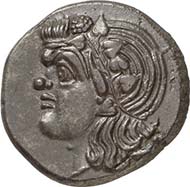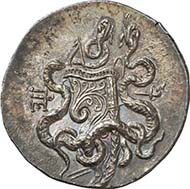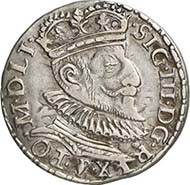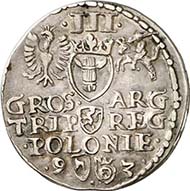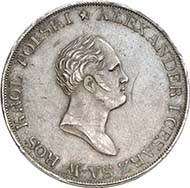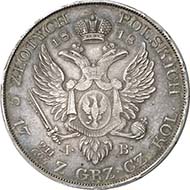10-10-2010 – 13-10-2010
Auction 190-193
Review Gorny & Mosch 190-193: quality and rarity set the coin price
On October 11th to 14th, 2010, Gorny & Mosch / Munich conducted no less than four auctions: auctions 190 and 191 containing ancient coins, 192 with medieval and modern coins and 193 which was devoted to Russian coins.
Especially in the top segment the prices rallied considerably. “Top segment” does not refer to coins with a high pre-sale estimate alone but to all pieces standing out from the mass of coins due to their state of preservation and their rarity. When these two aspects met in one single object, the bidders seemed to know no limit anymore.
Greek coins hotly favoured
This held true namely with the Greek coins. A first surprise was sprung by an extremely fine 100 litra piece from Syracuse of about 404 B. C. signed by Euainetos. Admittedly, the estimate of 7,500 Euros was a bit of an understatement considering the obverse die did not show the usual traces of rust. But a buyer finally paying 66,700 Euros really came as a surprise.
No. 90: PANTICAPAEUM (Tauric Chersonnes). Tridrachm, c. 325-300. SNG BM 879. Extremely fine. Estimate: 3,000 Euros. Realized price: 14,950 Euros.
Something similar happened to a rare tridrachm from Panticapaeum. The extremely fine piece had been estimated at 3,000 Euros and was sold in the end for 14,950 Euros. The cover piece, in comparison, was almost tolerable. The early Classical tetradrachm from Ainos rose from 6,000 to 19,550 Euros.
Likewise the impressive tetradrachm from Amphipolis with its en face portrait was not obtainable at its pre-sale estimate (75,000 / 115,000 Euros).
No. 236. PERGAMON (Mysia). Cistophorus, 160-150 B. C. Kleiner Series 11a. Splendid specimen. Extremely fine. Estimate: 1,000 Euros. Realized price: 5,290 Euros.
It is not possible to document here every piece that was sold for a price many times its estimate but one unusual result of a quite ordinary cistophorus from Pergamon nevertheless deserves mention at this point because it amazed even the experts in the subject. The sharply struck, well centered piece with a fine patina carried the large pre-sale price tag of 1,000 Euros. The end result was 5,290 Euros! The same occurred with a not at all rare, late Hellenistic bronze from the island of Rhodes, albeit with a fine malachite green patina. The extremely fine piece was estimated at 1,500 Euros – the gavel went down at 12,650 Euros.
Be it Archaic, Classical or Hellenistic – the buyers did not seem to care; the main thing was that a coin was well preserved and rare. An unpublished and extremely fine tetradrachm of Seleucus II with a magnificent portrait brought 41,400 Euros (estimate: 5,000).
The Romans failed to surprise equally. Reasonable collector prices dominated the scene. Bronzes, however, may still reach maximum prices when good style, fine patina and interesting depiction meet, as was the case with an extremely fine sestertius of Trajan with the representation of a bridge (3,000 / 16,100 Euros).
Extraordinary aurei, as always, yield very good results, like an extremely fine aureus of Hadrian with an unusually inspired depiction of the personification of Africa. Estimated at 4,000 Euros, the piece sold for 25,300 Euros. Likewise the prices have risen for Severan gold. A brilliant uncirculated aureus of Julia Domna with an attractive back view of Venus brought 20,700 Euros (estimate: 7,500 Euros).
Struggle for German Empire gold
The motto, that the price is set by the grade, holds true for modern coins as well. Rarity comes second, but may equally cause surprises.
These were experienced with Brandenburg-Prussia where a gold medal from 1744 weighing 5 times a ducat on the seizure of Prague climbed from its estimate of 2,500 Euros to 10,925 Euros. An about extremely fine, extremely rare 9 ducat piece of John George I, Elector of Saxony, excelled its estimate of 7,500 Euros when it was sold for the large sum of 21,850 Euros.
The real surprise, however, was caused by the actually readily comprehensible section of German Empire gold, not regarding the single piece but the overall area. The realistic estimate read 39,750 Euros. The end result added up to 62,387 Euros.
That bigger series generally promise to yield better results than scattered individual pieces was proven by a small series of Papal States which was included in catalogue 192. There, the collector discovered numerous medieval grossi of the Roman senate from the 13th century. Especially the well preserved pieces were sought-after – an extremely fine grosso, therefore, brought 975 Euros (estimate: 250 Euros).
No. 3905. POLAND. Sigismund III. Dreigröscher 1593, Marienburg. Kopicki 962 (R6). Very fine to extremely fine. Estimate: 150 Euros. Realized price: 2,070 Euros.
We are long aware of the fact that Polish coins rallied considerably in the recent years. Gorny & Mosch 192 confirms the trend. The high flyer became a very rare dreigröscher from 1593 graded very fine to extremely fine. The piece was modestly estimated at 150 Euros, but sold for 2,070 Euros. A showpiece, an oval medal on the coronation of Michael Korybuts from 1666 brought 9,200 Euros, and a medal of John III Sobieski from 1684 8,625 Euros, respectively (estimate each: 2,500 Euros).
That the Turkish coins, medals and honors are a good seller is known from the Dogan Collection auctioned off at Gorny & Mosch, at the latest. Auction 192 offered a Turkish Order of Charity, the Order of Nishan-i Shefkat. The piece, estimated at 500 Euros, was auctioned off for 8,050 Euros.
The lots’ prices, too, confirm the picture: since Gorny & Mosch is renowned for the meaningful assorting of the lots they always arouse great interest. The 14 lots were estimated at 3,700 Euros and were sold for 8,560 Euros.
Russian coins – still peak prices
What can be said about Russia? Simply, that peak prices are reached still. But let us have a closer look.
It is true that no bid seems to be high enough for the Russian coins of the Tsar era. The estimate does not matter – it will be excelled by far in any case. And when a piece comes in a good state of preservation and is likewise rare, money is of no concern anymore – so it seems.
A case in point is a very rare, extremely fine ducat from 1729 of Peter II from the Red Mint in Moscow. It was already estimated at 12,500 Euros, but reached a price of 115,000 Euros. The same happened to a rare, about extremely fine 10 rubel piece of Elizabeth from 1757 from St. Petersburg. Whereas the estimate was 30,000 Euros, the realized price was nothing less than 80,500 Euros.
Increasing interest is paid to the unspectacular fractions as well. In the last years, perfect low-value coins reached prices which were hitherto known only from gold and crown-like silver coins. Hence, an extremely fine to mint state poltina from 1794 was estimated at 750 Euros and rose to 12,650 Euros! And yet another time, although not that spectacular: a 20 kopek piece from 1776 (250 / 5,520 Euros). When one turns to the small series of three perfect pieces of Catherine II for Crimea – 20, 10 and 2 kopeks – one virtually gasps for air. Together, they were estimated at 15,000 Euros, but the result added up to 89,125 Euros – with the smallest coin reaching more than two times the price of the other two.
No. 5267. RUSSIA. Alexander I for Poland. Pattern of 5 zlotych 1818, Warsaw. Bitkin 907. Unique specimen. Extremely fine to brilliant uncirculated. Estimate: 10,000 Euros. Realized price: 149,500 Euros.
The most expensive coin of the auction became a rather unimpressive pattern of the 5 zlotych piece 1818 for Poland. The unique specimen with a beautiful patina, graded extremely fine to brilliant uncirculated, was estimated at 10,000 Euros and was auctioned off for 149,500 Euros. Whereas the modern commemorative coins of the USSR are not that much sought-after anymore, some patterns of the circulation money of the newly founded Communistic state were incredibly popular. 6 pieces were on offer with an estimate of 6,400 Euros in total. The end result read roughly 26,500 Euros!
In any case, there will be another Munich auction week conducted next March. Make sure to order you catalogue at Gorny & Mosch, Giessener Münzhandlung, Maximiliansplatz 20, D-80333 Munich, phone +49 / (0)89 / 24 22 643-0, fax +49 / (0)89 / 22 85 513.
If you want to order the coming catalogues, please click here.
The results of all auctions can viewed at
http://www.gmcoinart.de/index.php?lang=en&area=auctions&content=ergebnis



